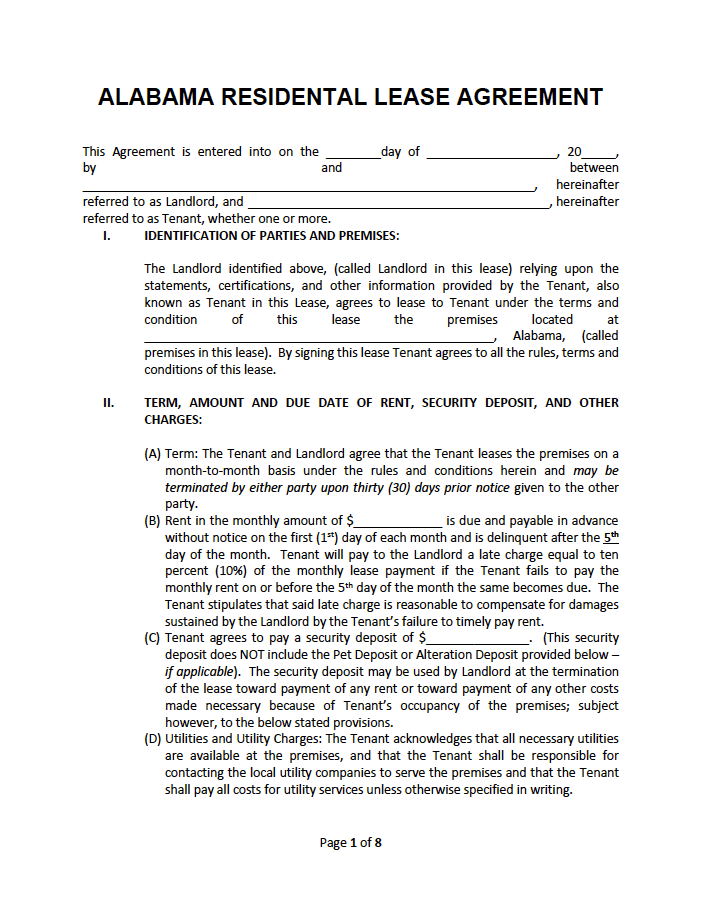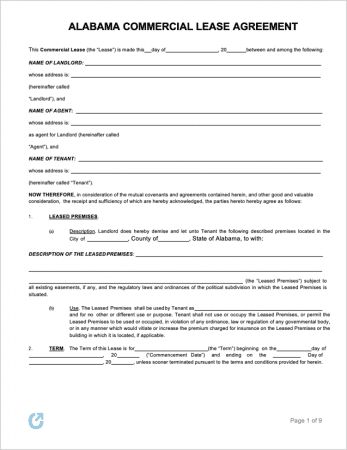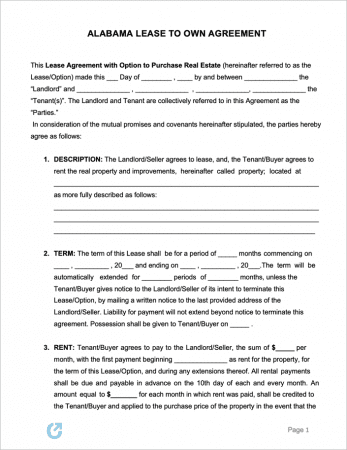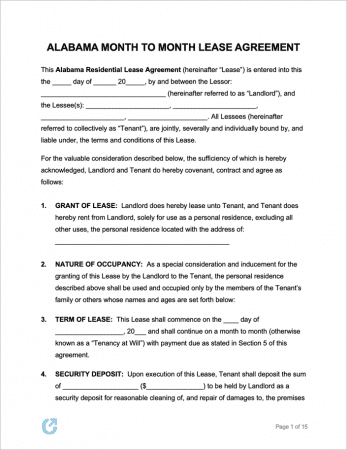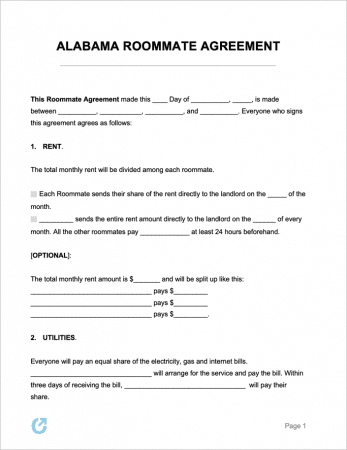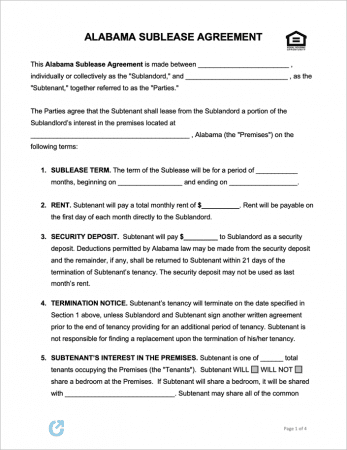Alabama Rental Lease Agreement Templates
The Alabama Rental Lease Agreements are documents signed between a landlord and tenant for the renting of residential or commercial space.
In simple terms, the agreement outlines each party’s obligations, including, but not limited to start and end dates (unless month-to-month), rent amount ($), utilities and services, and other miscellaneous expenses and commitments. Once an agreement is signed by the landlord and tenant it becomes a legally binding contract.
Types (6)
| Commercial | Lease-to-Own | Monthly| Roommate | Standard | Sublease |
Addendums (6)
Download: PDF
 Enclosed Garage, Carport, or Storage Unit
Enclosed Garage, Carport, or Storage Unit
Download: PDF
Download: PDF
Download: PDF
Download: PDF
Download: PDF
What is an Alabama Lease Agreement?
An Alabama Lease Agreement allows one (1) or more tenants to occupy a livable space in exchange for money paid on a regular basis. Before an agreement is signed, it’s highly recommended to have the tenant complete a rental application to verify employment, income, and credit history.
State Laws & Guides
Laws: Alabama Uniform Residential Landlord and Tenant Act
When is Rent Due?
In Alabama, rent is due on the date stated in the agreement. If nothing is specified in the form, rent should be paid on a monthly basis for standard leases, and on a weekly basis for week-to-week agreements. There is no grace period. (§ 35-9A-161(c)).
Landlord’s Access
Emergency (§ 35-9A-303(b)(1)): Landlord may enter the residence, without the tenant’s consent, in the case of an emergency.
Non-Emergency (§ 35-9A-303(c)): Landlord may enter the residence with two (2) days’ notice by posting a note on the door of entry. The note must state the day and time the landlord intends on entering the property and is required that it be during reasonable times.
Landlord’s Duties
In accordance with § 35-9A-204, landlord’s are required to provide the following duties for tenants:
- Repairs: conduct any and all repairs and take the necessary steps to keep the rental unit in an operatable, livable state.
- Garbage: ensure tenants have access to means of removing trash (dumpsters, bins, removal service, etc.).
- Common Areas: keep any and all common areas clean and safe for tenants.
- Maintenance: maintain all electrical, plumbing, HVAC, sanitary, and all other appliances, facilities, or amenities included in the lease.
- Running water & heat: provide tenants with running water and (reasonable) amounts of hot water at all times.
Tenant’s Duties
As stated by § 35-9A-301, the tenant has to uphold the following duties while bound by a lease:
- Cleaning: keep the area in which they rent both clean and safe.
- Trash: Remove all trash, ashes, and other garbage from the rental in a safe manner.
- Neighboring Tenants: refrain from disturbing other tenants’ peace.
- Damage: tenants cannot damage, deface, or remove any portion of the rental property.
- Use of Appliances & Plumbing: tenants must keep all plumbing clear (as reasonably possible) and use all appliances, fixtures, air conditioning, and other systems within reason.
Required Disclosures
Lead-Based Paint Disclosure: Required under federal law if the residence was constructed prior to 1978.
Names and Addresses (§ 35-9A-202): Landlord must write the contact information in the lease of either their name and address or the person authorized to manage the premises.
Retaliation (§ 35-9A-501(a)): In cases where the tenant has previously made a complaint to a government agency or institution, made a complaint with a landlord regarding a violation they committed, or becomes a member of a union, landlords cannot “retaliate” by removing services, raising the rent, or make threats if the tenant does so again.
Security Deposits
Maximum Amount (§ 35-9A-201(a)): One (1) month’s rent. Landlords can require an additional deposit(s) for pets, alterations to the rental, and for tenants who pose a more considerable risk than the average renter.
Returning to Tenant (§ 35-9A-201): Sixty (60) days. If the landlord does not return the deposit within the time-frame, the tenant shall be owed double. If the landlord is to make deductions from the tenant’s deposit, such amounts must be clearly stated in a list and provided to the tenant via their forwarding address, or the last known address if none was provided by the tenant.
Deposit Interest: Not required in Alabama.
Uses of the Deposit: Landlords can make deductions from the deposit for covering the cost of any unpaid rent or tenant-caused damages to the property (that occurred from a breach of the lease).
